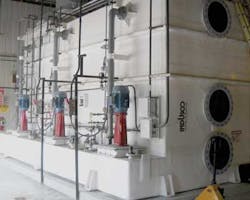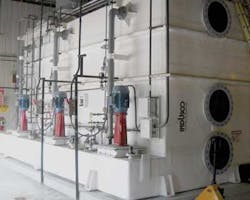With tourism one of the largest industries of Lowell, the fourth largest city in Massachusetts, control of odors from its wastewater treatment facility is a top priority. Situated on the Merrimack River, the city's National Historical Park includes historic cotton textile mills, 5.6 miles of canals, operating gatehouses and worker housing. The city is also the home of the world's largest textile museum and an authentic 1920s weaving room with operating looms that once were powered by the river.
The Lowell Regional Wastewater Utility, an ISO-14001 approved facility with a staff of 48 employees, serves the City of Lowell and the towns of Chelmsford, Dracut, Tewksbury and Tyngsboro. The treatment facility is designed to treat wastewater flows of 32 mgd. During wet weather conditions, the plant can treat as much as 110 mgd of combined sewage and stormwater, typically removing a minimum of 85 percent of the solid and dissolved contaminants. The biodegradation process, however, generates hydrogen sulfide (H2S) and ammonia (NH3), both of which have strong, offensive odors.
Until recently, the odor control system consisted of a 3-stage vertical packed tower scrubber.
"By 2009, the capacity of the tower scrubber had become insufficient to handle the increased flow of pollutants from the biodegradation process," said Tom Kawa, Operations Manager of the waste treatment facility.
The utility decided to install a new box scrubber from Indusco Environmental Services of Atlanta, GA. Operating since March 2010, it is the largest box scrubber in the industry, rated for 28,000 cfm of air flow, and has been certified to achieve 99.9 percent efficiency in H2S removal.
The three fluids circulating through the odor scrubber - sulfuric acid and sodium hydroxide, both of which are extremely corrosive, and sodium hypochlorite, a powerful oxidizing agent - require special pumps.
The original tower scrubbers used horizontal centrifugal pumps made of fiberglass that required constant maintenance to repair leaks due to the porosity and wicking of the material.
"In addition, the horizontal pumps were different sizes, requiring us to maintain a large inventory of spare parts to repair the leaks," Kawa said.
When Indusco installed the box scrubber, it replaced the fiberglass pumps with Sump-Gard® SGK-2000 cantilevered, vertical, bearingless, thermoplastic pumps from Vanton Pump & Equipment Corp., which have no seals to fail.
"The pumps have been circulating each of the three scrubbing fluids without leaks, requiring only routine maintenance since they were installed," said John Venegas, Indusco project manager.
Every wetted surface in the three identical Sump-Gard pumps is made of solid, inert polypropylene to eliminate corrosion and minimize abrasion, reducing maintenance and prolonging pump life. The stainless steel shaft is completely isolated from the corrosive fluid by a heavy-sectioned polypropylene sleeve. No metal comes in contact with the pumped fluid. The cantilevered, large diameter shaft eliminates the need for any immersed bearings and permits dependable operation without damage under dry running conditions caused by sudden fluid stoppage for short, extended or indefinite periods.
With 15 hp chemical-duty motors, the pumps operate at 500 gpm flow against 40 ft. of head. Each measures 19 inches from the baseplate to the bottom of the pump and 22 inches from the baseplate to the thermoplastic basket strainer with which they are fitted to remove any solids. The intake base of each pump measures 15.5 inches in diameter, with a distance of 13.25 inches from its center to the center of the outlet pipe.
The box scrubber and the packed tower scrubber operate on the same 3-stage principle. Sulfuric acid (H2SO4) in the first stage removes ammonia by converting it into ammonium sulfate, a non-volatile, water-soluble salt.
In the second stage, sodium hydroxide (NaOH) removes hydrogen sulfide by converting it to sodium sulfide, another non-volatile, water-soluble salt. Both the ammonium sulfate and the sodium sulfide are removed by blowdown, or flushing, with fresh water.
In the third stage, both sodium hydroxide and sodium hypochlorite (NaOCl) oxidize the remaining sulfur-containing compounds to the non-volatile, water-soluble salts, sodium sulfate and sodium chloride. Both are removed by blowdown. The sodium hypochlorite solution is generated onsite by electrolysis of salt water or brine.
WaterWorld Articles Archives




